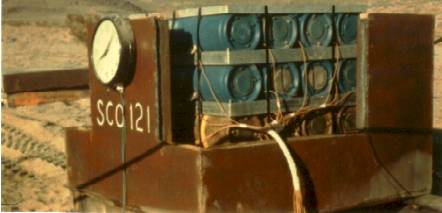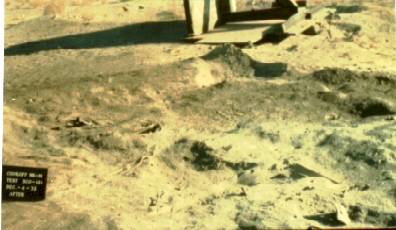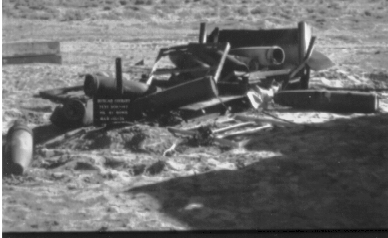Scientists at China Lake, CA conducted tests to support the government legal staff defending the Navy in the multi-million dollar suits filed as a result of the Roseville train explosion. The objective was to recreate the conditions that started the explosive reaction and demonstrate the results of a fire in the floor of a boxcar filled with bombs. A model was constructed to duplicate the corner of the boxcar with a pallet of bombs in place. The oak floor on the model was heated until it started to smolder. After about six hours, the bombs detonated.

Model boxcar corner simulating the conditions existing before the Roseville train explosion. |

Site after the bombs reacted in the boxcar fire experiment. |
This test result and the fact that someone had witnessed a fire on the train before it had entered the yard in Roseville satisfied the Navy legal staff that the cause of the accident was indeed known and that chemical instability of the explosives did not cause the explosions. No further tests were needed to support the government case.
The Navy scientists took advantage of the hardware left over from these tests to see how some of the new explosives would react under the same conditions. They loaded PBXN-107 (RDX/inert binder) into the remaining MK 81 bomb bodies and repeated the test. The reaction obtained was very mild. One of the bombs split open and the explosive burned. The other bombs in the stack rolled to the side of the test stand and sustained no damage

Test site after the PBXN-107 loaded bomb in a simulated boxcar fire experiment. |
The result of this test and other data reinforced our belief that these new explosive materials could indeed reduce the vulnerability of large munitions in fires and minimize damage that could result in cook-off situations. Filling large munitions with this type of explosive would substantially increase ship survivability, and reduce transportation hazards.
These new explosives were more complicated and more costly to load when compared to the TNT-based formulations then used in most munitions. This combined with the cost of qualifying31 a new explosive for a munition and the danger of not meeting program milestones with the new explosives seemed too risky to even the most progressive program managers. As with any research and development program, the data were limited and there was no guarantee that the improvements in safety and the performance would be as we advertised once these new explosives were in production; the limited laboratory data, however positive, could not overcome the perceived risks existing in the minds of the program managers.
31NAVORDINST 8020.12, “Qualification Procedures for Navy Explosives” issued on 27 September 1971.